MARIANI’S
October
28, 2007
NEWSLETTER
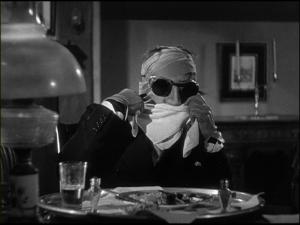
Claude Rains as "The Invisible Man" (1933)
HAPPY HALLOWEEN!
NEW! Click esquire.com
to go to my new biweekly column at Esquire
Magazine. This week: "The Six Best Food
Movies Ever Made."
ARCHIVE: Readers may now access
an
Archive of all past newsletters--each annotated--dating back to July,
2003, by simply clicking on www.johnmariani.com/archive
SUBSCRIBE AND
UN-SUBSCRIBE: You may subscribe anyone you wish
to this newsletter--free of charge--by
clicking here.
In
This Issue
NEW YORK CORNER: RUSSIAN SAMOVAR by Mort Hochstein
NOTES FROM THE WINE CELLAR: A New Book on
WHAT'S COOKING IN BOSTON?
by John Mariani and Henry Togna
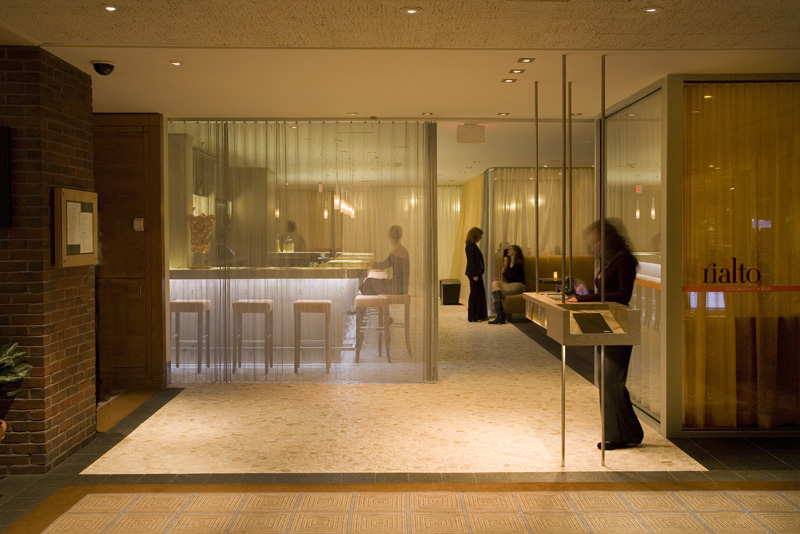
617-661-5050
www.rialto-restaurant.com
Thirteen years ago chef Jody Adams, with partner Michaela Larson, opened Rialto in Cambridge, featuring a menu of Mediterranean food that rightfully garnered both local and national acclaim, including a nod from Esquire. Larson has moved on to open Rocca (see below), while Adams, a respected figure in Boston’s gastro-evolution, shut Rialto down, then re-opened it last January with a completely new look and a menu that shows how broadly and deeply she has come to understand Italian regional food.
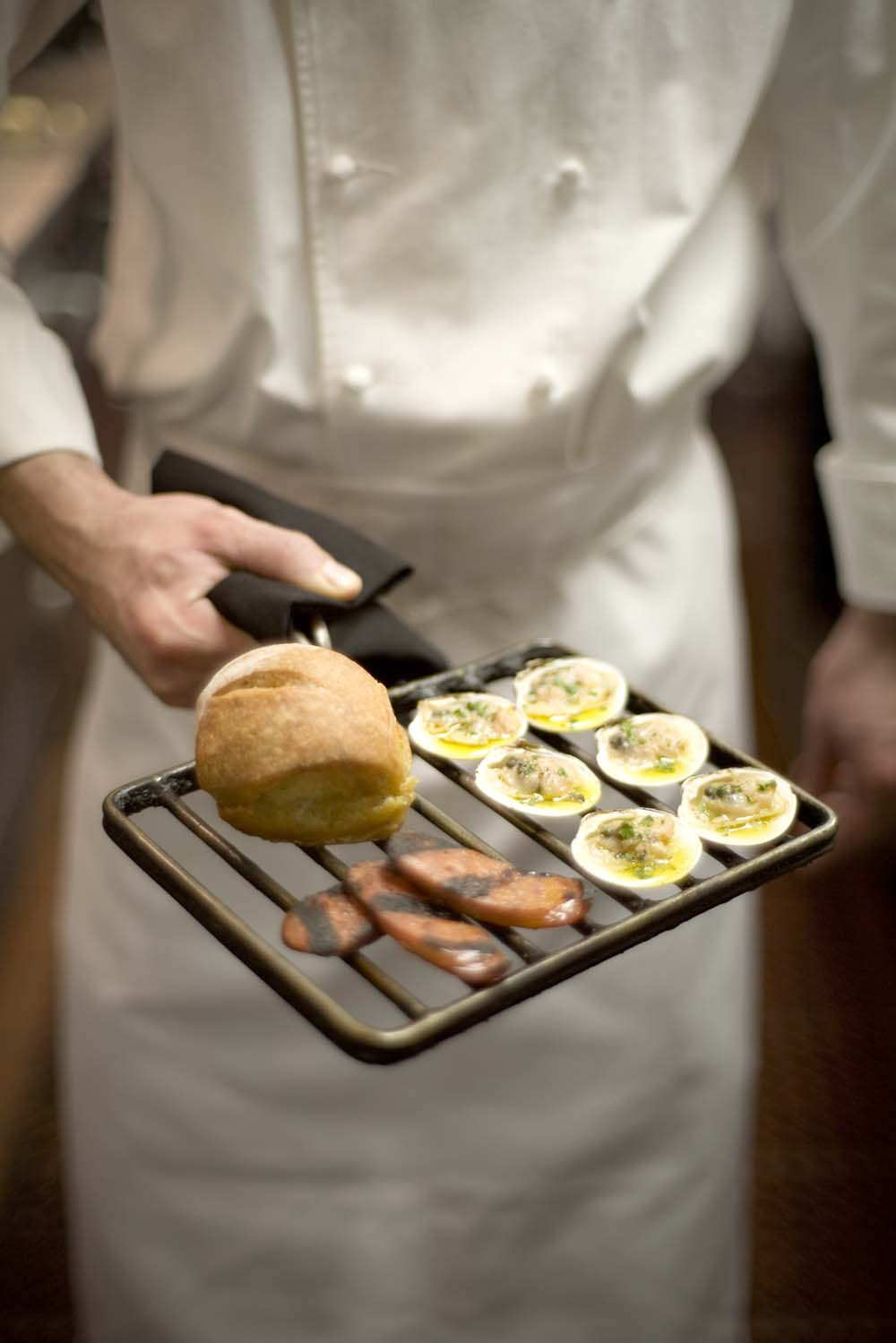 Adams, who has won about every culinary award
possible, has kept some of the
dishes her regulars begged her not to remove, like the grilled clams
with andouille sausage and garlic roll (left) and the roast duck with
escarole
and green olives. But she now changes the menu monthly to feature a
different region of Italy; when I visited she was serving authoritative
but highly personalized dishes from Sicily, starting off with fava
beans, fennel, and ricotta slathered on crisp country bread, then
house-made tagliatelle with
the season’s shad roe, pancetta, and
greens. There was also luscious spaghetti with lobster, and a smoky
mixed grill of swordfish and tuna with sweet and sour eggplant,
tomatoes, and artichokes. For dessert that is a delightful "cannoli
undone" with ginger, almond, and passion fruit sauce by pastry chef
Susan Abbott.
Adams, who has won about every culinary award
possible, has kept some of the
dishes her regulars begged her not to remove, like the grilled clams
with andouille sausage and garlic roll (left) and the roast duck with
escarole
and green olives. But she now changes the menu monthly to feature a
different region of Italy; when I visited she was serving authoritative
but highly personalized dishes from Sicily, starting off with fava
beans, fennel, and ricotta slathered on crisp country bread, then
house-made tagliatelle with
the season’s shad roe, pancetta, and
greens. There was also luscious spaghetti with lobster, and a smoky
mixed grill of swordfish and tuna with sweet and sour eggplant,
tomatoes, and artichokes. For dessert that is a delightful "cannoli
undone" with ginger, almond, and passion fruit sauce by pastry chef
Susan Abbott. The place looks great—Americana now replaced with glass and gauzy fabrics, with very romantic lighting and round booths facing an open antipasti counter. Rialto is not a re-hab; it is a great new restaurant with a fine pedigree.
"I have an enormous amount of respect for local cooking traditions," says Adams. "Technique on its own doesn't count for much. A new technique or personal interpretation only becomes part of the tradition when it enhances the taste of the dish's ingredients." Amen!
Rialto is open for dinner only daily. Appetizers run $5-$14, main courses $12-$36, with a prix fixe menu depending on the season.
ROCCA Kitchen & Bar
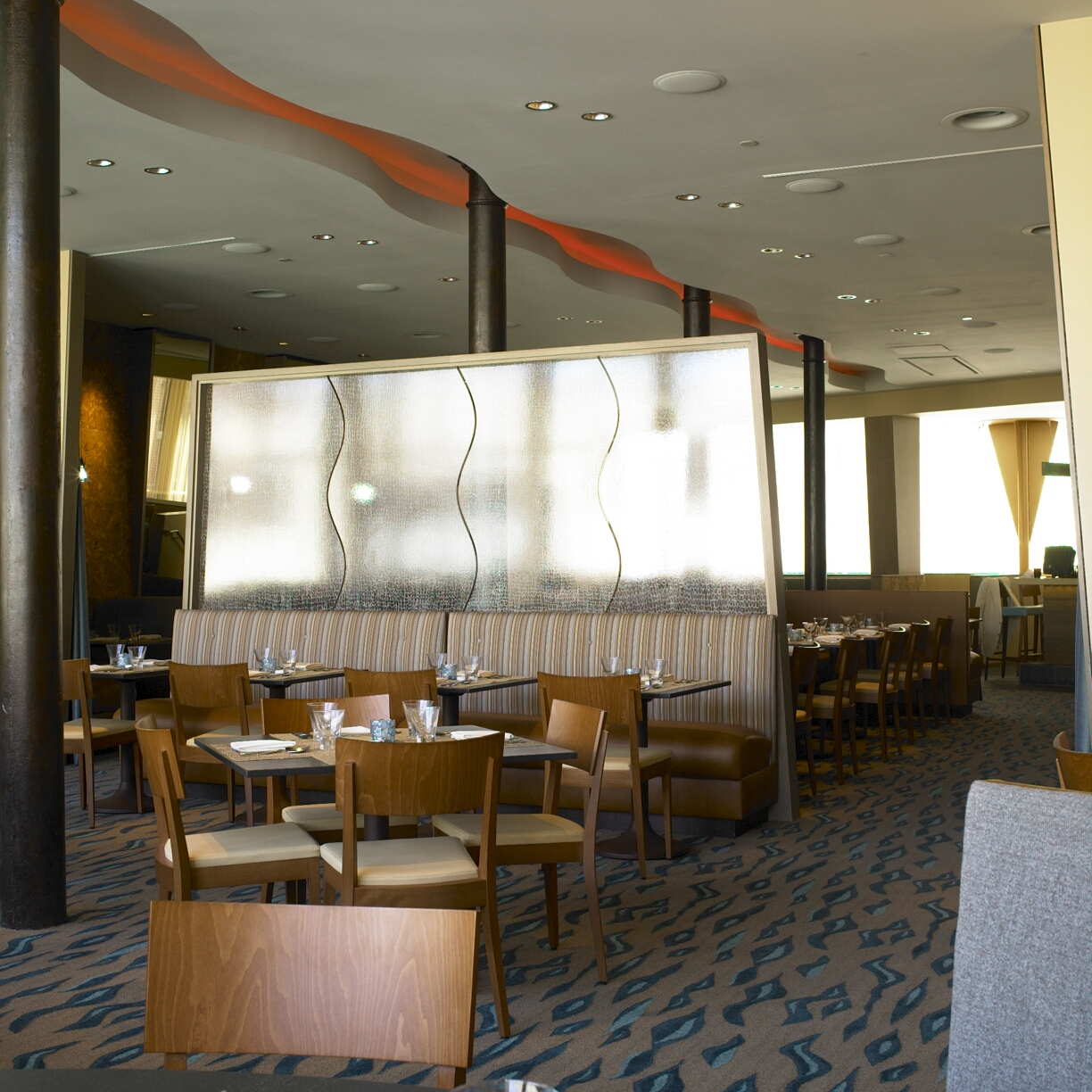
500 Harrison Avenue, Boston
www.roccaboston.com
Michaela Larson’s leaving Rialto (see above) to her former partner Jody Adams brought her to Boston’s South End to open Rocca, where she brings into play her passion for the food of Liguria, that stretch of rippling coastline referred to as the Italian Riviera, teeming with fabulous seafood and possessed of great olive oil and the finest sweet basil in the world, the basis of the region’s signature pesto dishes. It is also a region few Americans know much about, though well they should. Liguria has some of the most delicious food in Italy, and while its wines are rarely among the highest rated--the whites are the way to go--they do accompany the radiant cooking of the area, which is as rich in olive oil, nuts, and herbs as it is in seafood.
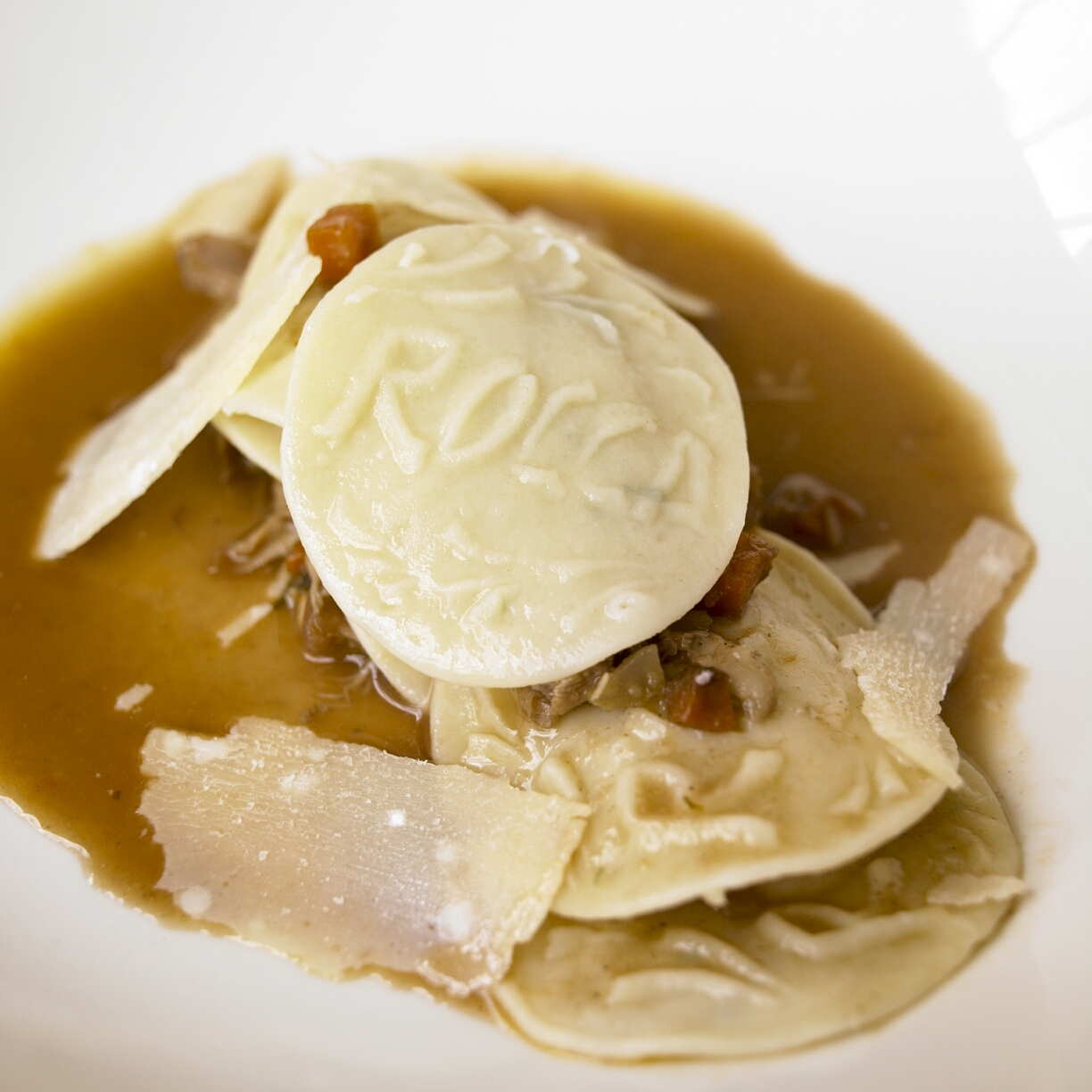 After
frequent, intensive eating excursions to Liguria, Larson has managed to
nail the flavors of the region, from pastas like trofie with a
verdant pesto, to fat panzotti with walnut sauce, and chestnut
flour corzetti with braised rabbit and red wine (left). The San Remo pizzette with tomatoes, capers,
olives, anchovies, and herbs is amazingly good, as is the selection of
sliced salume, fresh, juicy
mozzarella, and Italian cheeses here as part of the seasonal antipasti. Veal involtini are stuffed with
mozzarella, prosciutto, and basil and set on an herbed risotto with
tomato sauce. Sea bass is
perfectly cooked with herbs, and for dessert get the walnut-fig torta
with a glass of vin santo or finish off with
"smashed almond bark: with a dark chocolate dipping sauce. This
is food I could easily eat twice a week. Maybe more.
After
frequent, intensive eating excursions to Liguria, Larson has managed to
nail the flavors of the region, from pastas like trofie with a
verdant pesto, to fat panzotti with walnut sauce, and chestnut
flour corzetti with braised rabbit and red wine (left). The San Remo pizzette with tomatoes, capers,
olives, anchovies, and herbs is amazingly good, as is the selection of
sliced salume, fresh, juicy
mozzarella, and Italian cheeses here as part of the seasonal antipasti. Veal involtini are stuffed with
mozzarella, prosciutto, and basil and set on an herbed risotto with
tomato sauce. Sea bass is
perfectly cooked with herbs, and for dessert get the walnut-fig torta
with a glass of vin santo or finish off with
"smashed almond bark: with a dark chocolate dipping sauce. This
is food I could easily eat twice a week. Maybe more.The place is very casual, with the hip California luncheonette look of the 1960s, kind of "77 Sunset Strip." Begin downstairs at the bar with a negroni or a bottle of sparkling prosecco, then step up to a large dining room (above, right), formerly a warehouse, with a retro-industrial look of brick and cork walls, Italian movie posters, comfortable banquettes, bare coffeehouse tables, and Italian glassware. It all rings true at Rocca: maybe they should put up a white sheet and show Fellini movies on the wall.
Rocca is open for dinner only nightly and Sunday for brunch. Appetizers run $3-$12, main courses $10-$24.
MIEL
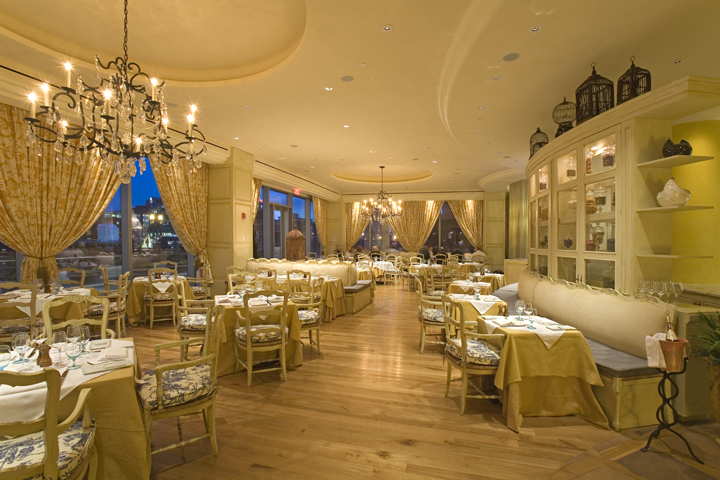
617-217-5151
There are two restaurants worth checking out at the InterContinental, one for its honest devotion to French brasserie fare, the other to a very cool ambiance and cocktail service that has made it very popular.
Miel is committed to organic ingredients of the kind farmed and found wild in the south of France, and they all find their way onto Chef Didier Montarou's menu. (Michelin star chef Jacques Chibois is a consultant here.) There are pastel Provençal colors and flourishes throughout the big, sweeping interior dining room (right), with 120 seats, but if the weather is good, by all means take a harborside table al fresco. One very welcome virtue--Miel is open 24/7, with late night dining after midnight.
On premises is a 360-degree round Olive Oil Museum that functions also as a private dining room, with a California olive wood table and an amazing array of olive oils from around the world, all of which are for sale.
The menu at Miel pretty much runs the gamut of French country classics, from a fine, restorative pistou teeming with basil and garlic, to a tuna Niçoise with beans, olives, hard-boiled egg, tomato, peppers, basil, and artichoke. The aroma of Pastis-scented escargots with aïoli-slathered toast, and the shrimp sautéed with fennel seeds, garlic, and Pernod is enough to make you
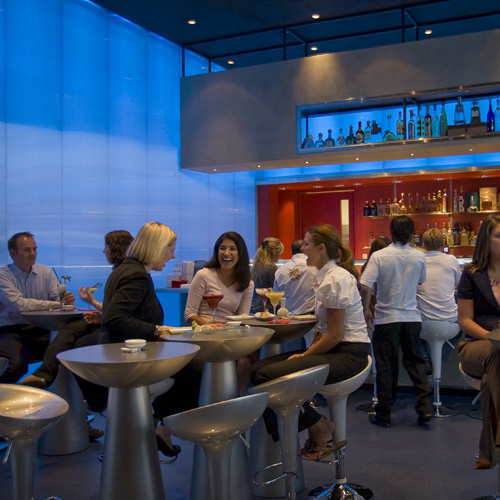 want to order both, and they also have serve up a good
foie gras terrine with honey and Port gelée. I also
recommend the thick, seared filet mignon with truffled béarnaise
sauce and crisp, golden pommes
frites. This being a hotel dining area, they also serve American
favorites like shrimp cocktail, club sandwich, and cheeseburgers, but
no one says you have to order them. For dessert indulge yourself
with crème brûlée or an artisanal cheese platter,
and sip a good Provençal wine from a list of solid offerings
that go well with this cooking.
want to order both, and they also have serve up a good
foie gras terrine with honey and Port gelée. I also
recommend the thick, seared filet mignon with truffled béarnaise
sauce and crisp, golden pommes
frites. This being a hotel dining area, they also serve American
favorites like shrimp cocktail, club sandwich, and cheeseburgers, but
no one says you have to order them. For dessert indulge yourself
with crème brûlée or an artisanal cheese platter,
and sip a good Provençal wine from a list of solid offerings
that go well with this cooking.Miel is open for breakfast, lunch, and dinner. At dinner, appetizers are $7-$16, entrees $14-$42.
I had a tequila cocktail but did not eat at Sushi-Teq (left), next door to Miel, but it is worth mentioning for the snazzy, very hip decor, and the interesting mix--which works well--of a tequila bar, with 69 labels, and sushi. It seats only 40 and is great for a pre-theater nosh or as a place to meet friends afterwards (it stays open till 2 AM). Check out the entire menu to see the variety and serious commitment to fine sushi and sashimi.
30 Gloucester Street
617-262-3023
www.lespalier.com
by Henry Togna
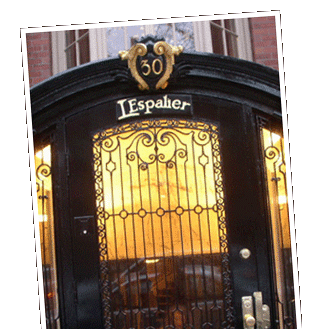 For
two decades now L'Espalier in Back Bay has had an enviably high
reputation for formal "New England-French Cuisine," but a recent visit
showed that its considerable merits in cooking are not matched by what
almost seems
almost a satire on modern restaurant service.
For
two decades now L'Espalier in Back Bay has had an enviably high
reputation for formal "New England-French Cuisine," but a recent visit
showed that its considerable merits in cooking are not matched by what
almost seems
almost a satire on modern restaurant service.The lovely Brahmin townhouse dates to 1880, once a private home, and, for a while, according to the restaurant's website, "notorious for its wild parties in the 1960s." Originally opened by Chef-owner Frank McLelland on Boylston Street in 1978, L'Espalier moved to the current premises in 1988, now with three dining rooms. Along the way, McLelland picked up a James Beard Awards as Best Chef in the Northeast. On L'Espalier's website McLelland (below) notes that,
Upon arrival, we were greeted by two unsmiling reception girls who were
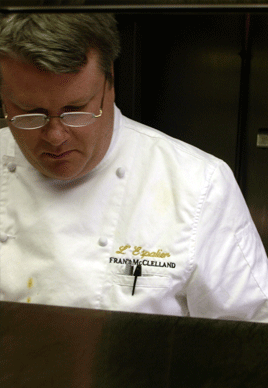
To say that the décor was dull would be an understatement,
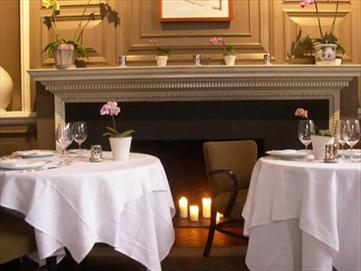 on
on Here was a case of an evening of very good haute cuisine brought down by a style of service that pretends to be classically refined and professional, when in fact it was pretentious and, ultimately, off-putting. Putting the guest first is far preferable than putting on airs.
NEW YORK CORNER
RUSSIAN SAMOVAR
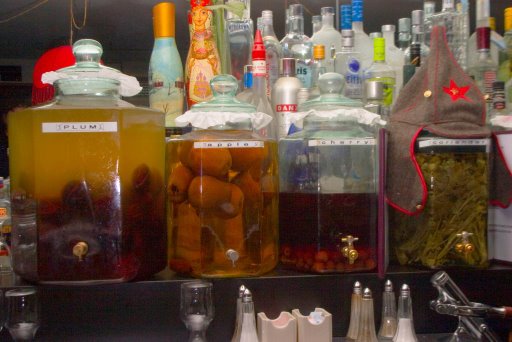
212-757-0168
by Mort Hochstein
 Here’s
where you might find customers inclined to break into song, Russian.
operatic
or pop, to accompany the pianist, who is part of the nightly dining
scheme or others
standing up to recite poetry. You might
encounter many Russian notables, most of whom you probably will not
know except for
Mikhail
Baryshnikov, who was actually a founder of the
restaurant along with the Nobel-prize
winning poet, the late Joseph Brodsky. You might also find owner Roman
Kaplan
matching lines of Pushkin with a tablemate, as he did one recent
evening with
my wife, Rolaine.
Here’s
where you might find customers inclined to break into song, Russian.
operatic
or pop, to accompany the pianist, who is part of the nightly dining
scheme or others
standing up to recite poetry. You might
encounter many Russian notables, most of whom you probably will not
know except for
Mikhail
Baryshnikov, who was actually a founder of the
restaurant along with the Nobel-prize
winning poet, the late Joseph Brodsky. You might also find owner Roman
Kaplan
matching lines of Pushkin with a tablemate, as he did one recent
evening with
my wife, Rolaine.As I surveyed the scene, I was reminded of the legendary
A visitor might recognize tennis star and US Open champion Maria Sharapova, who hangs out in season, or writer Norman Mailer, or Liza Minnelli, who recently took the mike for some improvisation, or instrumentalist Wynton Marsalis. The faces of Phillip Roth and actress Nicole Kidman (below, with owner Roman Kaplan) hang on the wall amid photos of visiting Russian notables, along with a gallery of Russian art from Kaplan's own collection. In the late hours of the evening, the bar morphs into a hangout for after-theater celebrants who enjoy the Samovar ambiance and its flavored vodkas (above), a spirits innovation which Kaplan claims to have introduced to American imbibers.
Although the menu offers traditional Russian cuisine, the man behind the stoves has roots in other soils. He is French-born and -trained Patrick Allouache, a veteran of several Michelin-starred restaurants in his homeland. Allouache serves a hearty wild mushroom soup, a full-bodied broth, thick with shiitakes,
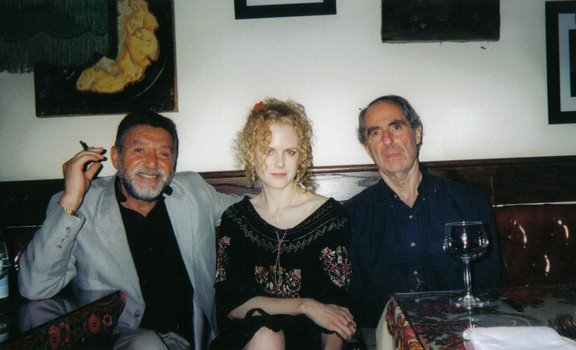 crimini, and porcini,
making me think that someone in that kitchen had picked them in the
forests of
suburbia and reminding me of a Russian neighbor who told me I was
foolish for
not feasting on the mushrooms that grew in my suburban yard. The visual
standout
on the appetizer list is the Royal Baltic Fish Platter (below)
a gigantic assortment of
smoked salmon, salmon roe,
sturgeon
and two kinds of herring. My wife opted
for a more traditional dish, brilliant red beet
borsch
accompanied by a crispy and tasty meat-stuffed pirozhok (think empanada in
Russian).
crimini, and porcini,
making me think that someone in that kitchen had picked them in the
forests of
suburbia and reminding me of a Russian neighbor who told me I was
foolish for
not feasting on the mushrooms that grew in my suburban yard. The visual
standout
on the appetizer list is the Royal Baltic Fish Platter (below)
a gigantic assortment of
smoked salmon, salmon roe,
sturgeon
and two kinds of herring. My wife opted
for a more traditional dish, brilliant red beet
borsch
accompanied by a crispy and tasty meat-stuffed pirozhok (think empanada in
Russian).I fought the temptation of a huge plate of blini (tiny buckwheat pancakes with osetra and salmon caviar, salmon and sable, herring and chopped eggs and onions) or coulibiac (salmon baked in pastry), a two-day effort we have served at home as a party dish. I opted for a simple order of pelmeni, small meat dumplings served in a light broth. A peasant at heart, I savored the tasty dumplings, sparked by spicy mustard and sour cream on the side. As for my wife, she was still searching for the chicken Kiev of her dreams, a dish that had disappointed her twenty years ago when she participated in an oxymoronic culinary tour of the then-Soviet
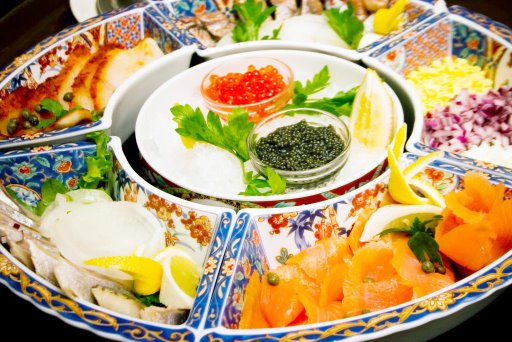 Owner Kaplan was passing by and he
noticed my wife’s disappointment. Kaplan
took a knife and warned her to sit back. He
delivered a sure-handed slash to the
chicken and smiled triumphantly as the butter burst forth. After the pyrotechnics, my wife was rewarded
with more of what she had been hoping for--a tender, moist and
flavorful
Chicken Kiev, after all those years of searching.
Owner Kaplan was passing by and he
noticed my wife’s disappointment. Kaplan
took a knife and warned her to sit back. He
delivered a sure-handed slash to the
chicken and smiled triumphantly as the butter burst forth. After the pyrotechnics, my wife was rewarded
with more of what she had been hoping for--a tender, moist and
flavorful
Chicken Kiev, after all those years of searching.We decided to go French with dessert and ordered chef Allouache’s tribute to his Gallic heritage, a huge napoleon pastry--big enough for four, it was a formidable, towering assemblage of Bavarian cream flavored with Grand Marnier and fresh raspberries sandwiched between slivers of delicate pastry. I would guess the Czars might have enjoyed it as much as we did, leaving hardly a crumb on the plate.
Russian Samovar is a unique place, to be enjoyed as much for its ambiance as its hearty menu, the pianist often joined by improvising guests, the joie de vivre of the largely Russian audience in a setting that is as much Roman Kaplan’s parlor as commercial restaurant.
Toots Shor would have applauded.
NOTES FROM THE WINE CELLAR
John Mariani's weekly wine column appears in Bloomberg Muse News, from which this story was adapted. Bloomberg News covers Culture from art, books, and theater to wine, travel, and food on a daily basis, and some of its articles play of the Saturday Bloomberg Radio and TV.
A New Book on
by John Mariani
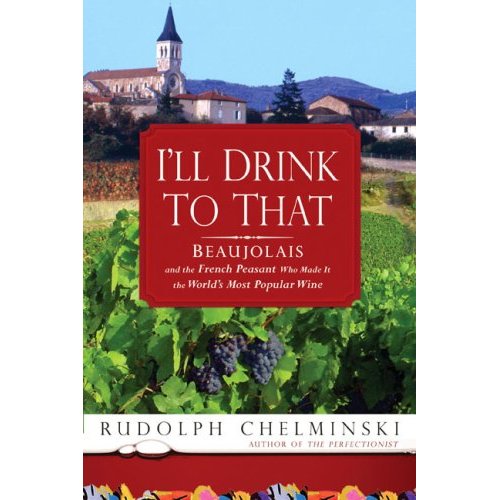
When Rudolph Chelminski announced to friends that the subject of his new book was to be
Chelminski’s book, I’ll Drink to That: Beaujolais and the French Peasant Who Made It the World’s Most Popular Wine (Gotham Books, $27.50) sets out not only to show that Beaujolais is a wine that can be the equal of all but the very finest crus in the larger region of Burgundy, but that it achieves that excellence at well under $20 a bottle. The French peasant of the book is the redoubtable Georges Duboeuf, known as the “King of Beaujolais,” who currently controls about ten percent of the wine’s total production and $100 million dollars in sales annually.
But before Duboeuf enters the picture, about halfway through the book, Chelminski details how thousands of peasants going back 700 years struggled to scratch a living from their out-of-the-way parcels of French terroir to produce wine from the gamay grape introduced there by the Duke of Burgundy. Their life was tremendously difficult, their rewards always in doubt, and not until the 18th century did Beaujolais dealers establish a safe,
 “fairly reliable
liaison with
the attractive Paris market” at a time when roads were improved and
barges
could be loaded with wine barrels for shipment northward. In Paris
Beaujolais quickly
became the standard red wine of the common people and of the new
bistros
dotting the city’s neighborhoods. When
trains and trucks entered the picture, allowing more regional wines to
get to
“fairly reliable
liaison with
the attractive Paris market” at a time when roads were improved and
barges
could be loaded with wine barrels for shipment northward. In Paris
Beaujolais quickly
became the standard red wine of the common people and of the new
bistros
dotting the city’s neighborhoods. When
trains and trucks entered the picture, allowing more regional wines to
get to Chelminski (right), author of The Perfectionist: Life and Death in French Cuisine (2005), is a highly engaging writer, mixing personal anecdote, character sketches, and telling details about the promotion and marketing of wine. He shows how the mere introduction of the horse to the
At this point in the story Georges Duboeuf enters, from a very old, though very common Maconnais bloodline. Duboeuf grew up on a farm with one horse, two cows, two goats and a pig, where only the women were engaged to milk the goats. Young Georges milked the cows, cut and stocked the hay, picked grapes, and drank the wine they made. In high school he wanted to be a sports trainer, perhaps in therapeutic massage. But his return to his
But he was a very canny young man. At a time when most wine of the region was sold in bulk from barrel, Duboeuf had the idea of bringing finished wines in bottle to local restaurants. His first visit was to a famous one, Le Chapon Fin, whose owner agreed to take the young man’s wines on a continual basis. He was on his way.
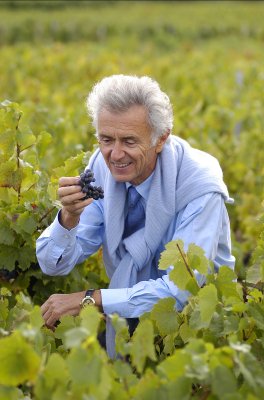 He set up
He set up Then, as of November 15, 1970, Duboeuf made Beaujolais fashionable overnight as the new, unfinished wine of the harvest was celebrated in parties throughout Paris bistros, sparked by “a little yellow handbill” that announced, “Le Beaujolais Nouveau Ést Arrivé!” From that point on Beaujolais Nouveau became a mid-November phenomenon, with wineshops and restaurants competing to be the first to serve the new wine in
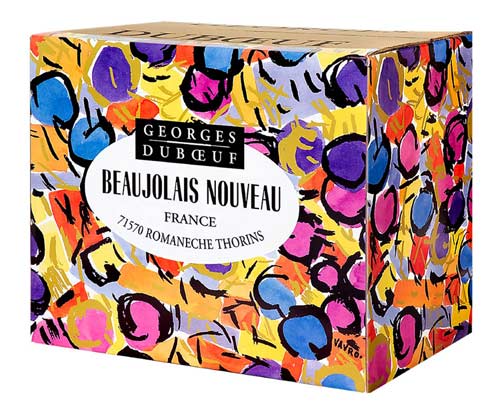
The rest of Chelminski’s book details how the success of this least-interesting example of Beaujolais came to dominate the wine’s reputation, which sank as a fashion even while outselling the more noble wines of the region, including the 10 crus like Julienas, Morgon, and Chiroubles. Sales fell, and the Beaujolais, especially Duboeuf, now 74, have been working ever since to buoy the image of a wine whose future is in considerable doubt. Indeed, as one of Duboeuf’s colleagues remarks at the end of the book, “Les plus courageux survivront”—the toughest of us will survive.
Chelminski ends, as he must, optimistic that Beaujolais will remain true to itself and its history, but admits that view is “arrant romanticism on my part.” Yet this is not a sad story so much as it is a very well-told, often rollicking, highly gustatory tale of a place and a wine often neglected, heavily promoted, and, like all else in the global market today, a fashion victim.
IN NEBRASKA THAT’S NOT ACTUALLY ALL THAT UNUSUAL

Tyler Riewer in

RUN THAT BY US AGAIN?
“See that hedge-fund guy in suspenders and John Lobb boots over there ordering a 2004 Bienvenue Batard-Montrachet Grand Cru from Domaine Leflaive? It sells for $275 at Zachy’s and consists of a single varietal, or grape, chardonnay. Now, calling such magnificent wine by its grape is like calling Beethoven a piano player, but even Beethoven started somewhere. `Chopsticks,’ anyone?”—S.S. Fair, “Chardonnay: An Apologia,” New York Times (Sept. 16. 2007).
QUICK BYTES
* On October 30,
* During November in
* On Nov. 8 Chef Staffan Terje and Umberto Gibin of PerBacco in
* On Nov. 8 New Orleans Chef Duke LoCicero of Café Giovanni will host a 5-course wine dinner featuring wines from Dog Lovers Wine Club to
* From Nov. 8-11 a Culinary Weekend will be held in Highlands, NC: In partnership with the Highlands Chamber of Commerce and Visitors Ctr., the Inn at Half-Mile Farm will offer a multi-night stay package with a complimentary 3rd night’s stay and a 4th night stay at
* On No. 9, 10 & 11, eight central
* On Nov. 11 Unicorn Restaurant in San Francisco hosts a 4-course Navarro Vineyards Wine Dinner for $85 pp. Jim Greaves of Navarro Vineyards will be in attendance; wine pairing by Unicorn sommeliers Joe Evinger Call 415-982-9828 or kiet@unicorndining.com.
* On Nov. 11, McCormick & Kuleto’s Seafood Restaurant in
* The Second Annual Midtown Atlanta Shop & Dine Week is set for Nov. 11-17, with a portion of proceeds to benefit Midtown Neighbors' Association. Participating area restaurants will offer special pricing and promotions, incl. Ecco, Food Studio, La Tavola, Park 75, Pleasant Peasant, Silk, South City Kitchen, and Sweet Lowdown will participate in the week's events. Fine dining restaurants will offer three-course menus for $25 per person, while casual restaurants will feature a meal for two for $25. Visit www.midtownatlantashopanddineweek.com.
* On Nov. 12 in Cambridge, MA, the fourth annual “FLAVORS OF FALL,” co-sponsored by BostonChefs.com and City Square Associates, will take place at Regattabar in The Charles Hotel, with local chefs serving hors d'oeuvres and confections in support of CYCLE Kids. Restaurants incl: Blue Room, Chez Henri, Casablanca, dante, Gargoyle's, Harvest, Henrietta's Table, OM, Rialto, Sandrine's Bistro, Upstairs on the Square. Silent auction items. Live jazz. $65 pp. Call 617-441-8600.
* On Nov. 13 the
* On Nov. 13 Fleming's Prime Steakhouse & Wine Bar presents "Red Rapture: The All-Red 90+ Wine Dinner," at its 50+ restaurants nationwide,
* From Nov. 14-18 the San Diego Bay Wine & Food Festival will be held, with a prize package awarded to the "Chef of the Fest" incl. a vacation for two to Turtle Island Fiji, a professional range provided by US Foodservice, magazine exposure in Dining Out and San Diego Magazines, $3,000 in cash, and a Tommy Bahama Rum Gift Basket. The festival benefits the American Institute of Wine & Food culinary arts scholarship program. Over 700 wines, 60 of
NEW FEATURE: I am happy to report that the Virtual Gourmet is linking up with two excellent travel sites:
Everett Potter's Travel Report:
Tennis Resorts Online: A Critical Guide to the World's Best Tennis Resorts and Tennis Camps, published by ROGER COX, who has spent more than two decades writing about tennis travel, including a 17-year stretch for Tennis magazine. He has also written for Arthur Frommer's Budget Travel, New York Magazine, Travel & Leisure, Esquire, Money, USTA Magazine, Men's Journal, and The Robb Report. He has authored two books-The World's Best Tennis Vacations (Stephen Greene Press/Viking Penguin, 1990) and The Best Places to Stay in the Rockies (Houghton Mifflin, 1992 & 1994), and the Melbourne (Australia) chapter to the Wall Street Journal Business Guide to Cities of the Pacific Rim (Fodor's Travel Guides, 1991). Click on the logo below to go to the site.
~~~~~~~~~~~~~~~~~~~~~~~~~~~~~~~~~~~~~~~~~~~~~~~~~~~~~~~~~~~~~~~~~~~~~~~~~
MARIANI'S VIRTUAL GOURMET NEWSLETTER is published weekly. Editor/Publisher:
John Mariani. Contributing Writers: Robert Mariani, Naomi
Kooker, Kirsten Skogerson, Edward Brivio, Mort
Hochstein, Suzanne Wright. Contributing
Photographers: Galina Stepanoff-Dargery, Bobby Pirillo. Technical
Advisor: Gerry McLoughlin.
Any of John Mariani's books below
may be ordered from amazon.com by clicking on the cover image.
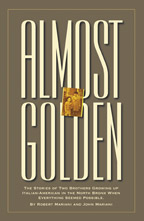 My
newest book, written with my brother Robert Mariani, is a memoir of our
years growing up in the My
newest book, written with my brother Robert Mariani, is a memoir of our
years growing up in the For those of you who don't think of the Robert and I think you'll enjoy this very personal look at our --John Mariani |
 |
 |
 |
 |
 |
 |
copyright John Mariani 2007

